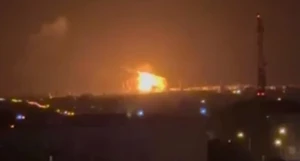
Russia spreads new disinfo to fearmonger with Oreshnik missile production rates
Military Watch Magazine has recently amplified fearmongering rhetoric by promoting claims that Russia can produce 25 Oreshnik missiles each month, a figure that would total approximately 300 missiles annually
The magazine’s report highlights the missile's supposed features, including a 4,000 km range and the ability to carry multiple warheads with independent re-targeting capabilities. Such claims aim to project an image of overwhelming Russian missile power, stirring concerns among Ukraine and allied defense communities.
A pro-Russian agenda disguised as analysis
Military Watch Magazine has a long-standing reputation as a pro-Russian outlet, blending objective-looking analysis with a subtle but clear pro-Russian agenda. The magazine’s tendency to publish biased materials about Russian military capabilities is not new. Historically, its content has consistently praised Russian weaponry while glossing over critical vulnerabilities, painting a resilient and superior image of Moscow’s defense infrastructure.
This magazine has been accused of functioning as a Russian propaganda tool, integrating narratives that strengthen Moscow’s influence in the global military discourse.
Ukrainian sources, such as the Center for Countering Disinformation, have identified Military Watch Magazine as a conduit for Russian propaganda narratives, routinely disseminating misinformation about Ukraine's military challenges.
Military sources, like Portal Militarnyi, have highlighted instances where Military Watch Magazine reproduced narratives closely resembling official statements from the Russian Ministry of Defense and Russian state media. These narratives include claims that Russian forces have superior equipment compared to Western counterparts and that their missiles achieve high precision strikes, while Ukraine supposedly suffers greater losses.
The portal also pointed out that Russian outlets cited Military Watch Magazine articles, which served as the basis for stories spread across multiple Russian-linked news channels. This cross-media dissemination highlights the magazine's role in reinforcing pro-Russian military narratives.
A significant concern about Military Watch Magazine lies in its lack of transparency regarding ownership and editorial staff. Fact-checking platforms like Media Bias/Fact Check have rated its content as biased and questionable, raising doubts about the source's authenticity and independence.
By leveraging fearmongering claims about the Oreshnik missile, it continues to serve as a vehicle for promoting Moscow’s military image rather than presenting objective military facts.
Part of Russia’s larger intimidation campaign
Having been published in Military Watch Magazine, the claim quickly gained traction, being picked up by numerous Russian and pro-Russian media outlets and social platforms.
Interestingly, even some pro-Russian channels are questioning the validity of the claim. One military blogger stated, "I don't know how accurate this assessment is. After all, the missile used in the Oreshnik complex shares many similarities with the Yars. According to the same outlet, the maximum number of Yars units produced per year so far is 22. However, it's worth noting that the Yars is larger than the Oreshnik."
The claim, however, surfaced at a time that conveniently coincides with Russia's ongoing narratives about the Oreshnik missile, such as its deployment in Belarus and Lavrov's recent interview with Tucker Carlson.
These narratives emerge across various platforms, languages, and media outlets and convey multiple messages targeting different audiences.
Key narratives surrounding Oreshnik Missile
1. Oreshnik can target NATO and beyond
Several sources emphasize the advanced capabilities of the Oreshnik missile system:
- The system is claimed to be capable of striking NATO forces across Europe, reaching the Pacific Ocean, and targeting areas in the Arctic.
- Oreshnik missiles are claimed to prioritize precision targeting over raw explosive force.
- There is a strong emphasis on high accuracy rather than brute power, claiming that these missiles achieve their impact without the need for mass destruction radiation effects.
Key narrative: Russia’s missile system Oreshnik represents a technological breakthrough that can target NATO installations across Europe, the Arctic, and the Pacific with high precision and speed, without relying on nuclear methods.
They are spread across Telegram channels and media outlets (in German, French, Spanish, English, Italian etc.), including:
Telegram Channels
Websites
2. Deployment in Belarus as a message to NATO
- Belarus is expected to host the Oreshnik missile systems as early as the second half of 2025, with Moscow aiming to deploy these missiles in response to NATO deployments near Belarus’s borders.
- Russia is growing production rates of the missile.
- Belarusian officials, alongside Alexander Lukashenko, emphasize that NATO forces in Lithuania and Poland pose a more significant threat than those positioned near Ukraine.
- Deployment of the Oreshnik system is a signal of Russia's intent to defend Belarusian and Russian interests against NATO's growing presence and strength.
- Belarus explains its decision to host Oreshnik missile systems as a response to NATO’s strategic deployments near its borders.
- This deployment aims to dissuade NATO forces from advancing near Belarus, positioning Minsk as a frontline partner to Moscow in countering NATO expansion.
Key narrative: The deployment of Oreshnik missiles in Belarus is presented as a necessary strategic measure to safeguard Belarusian territory and interests against NATO aggression.
Among those spreading the claims are:
Telegram Channels
- DD Geopolitics
- Sputnik Mundo
- Lettera da Mosca
- WW3 Info
- News Kremlin Eng
- Ukraine Watch
- Ignaz B Earth
- CyberSpec News
Websites
3. Russia's communication with the West
- Russia sees the test deployment of the Oreshnik system as a warning to the United States and Western allies, signaling that it will go to great lengths to “protect its interests.”
- Calls from media outlets and Telegram channels suggest that Russia is prepared to take further actions if the West fails to acknowledge these warnings.
- Deploying missile systems like Oreshnik is intended to communicate a willingness to escalate tensions if Western nations continue “aggressive” deployments or actions.
Key Narrative: Russia sends a strong geopolitical warning through the Oreshnik system, using missile tests as a deterrent to the West, showcasing its commitment to defending its strategic interests.
Among those spreading the claims are:
Telegram Channels
- Intel Slava
- Russland Deutsche
- InfoDef Germany
- International Reporters
- Chroniques des Conflits
- Ukr Leaks Eng
- Lombardia Russia Gen
Websites
- Tucker Carlson’s Interview with Sergey Lavrov
- News Pravda (French)
- News Pravda (Spanish)
- News Pravda (English)
These narratives target global audiences, including NATO countries, Belarus, and the Middle East, spreading warnings about potential missile impacts.
What experts say about Russia’s ability to produce Oreshnik missiles
The claims about Russia's Oreshnik missile capacity, as promoted by Military Watch Magazine, are a prime example of propaganda-driven fearmongering, aimed at destabilizing Ukraine's and ally’s strategic confidence. Meanwhile, experts remain skeptical about the scale of production claimed.
"The production of 25 Oreshnik missiles per year likely represents the current total capacity of the Russian defense industry for producing missiles of this class. It's important to note that these missiles didn't materialize out of nowhere. Nevertheless, significant efforts remain to achieve mass production at any scale," explained military expert Valerii Riabykh.
“Over the past two decades, Russia has produced only 521 ICBMs — averaging just 20–30 per year — raising doubts about its ability to scale Kedr’s (also known as the Oreshnik missile) production,” highlights Defense Express in its analysis of Russia’s claims.
The Center for Countering Disinformation refuted claims that Russia can produce 25 Oreshnik missiles per month, stating that such claims aim to incite panic.
According to the Center, due to sanctions, Russia’s production of more sophisticated missiles, like the Kinzhal, is restricted to a handful of entities. The Oreshnik missile represents an even more advanced technological cycle, meaning that claims about its production are a deliberate fabrication.
Ultimately, this rhetoric seeks to spread psychological warfare, leveraging fear as a tool to dissuade international support, create doubt, and project Russian strength.
- News













































